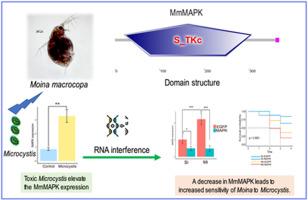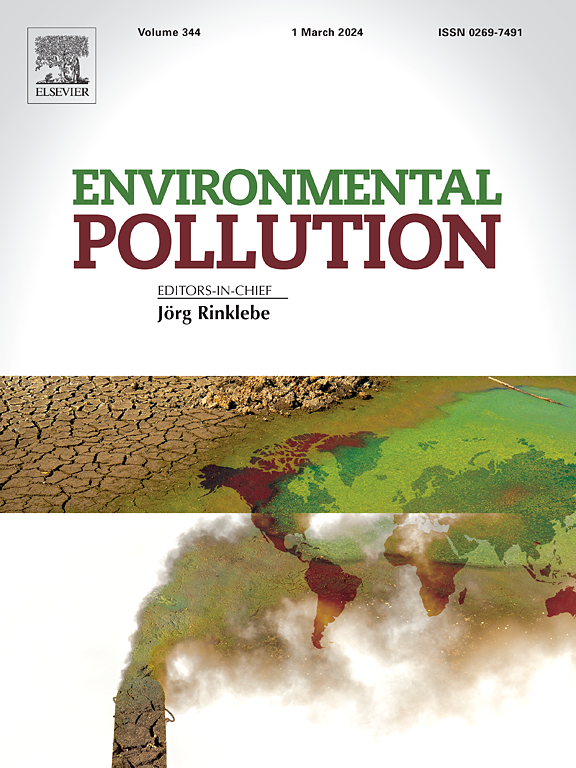p38 MAPK determines the sensitivity of the aquatic keystone species Moina macrocopa to toxic Microcystis: Insights into potential biomarker applications
IF 7.6
2区 环境科学与生态学
Q1 ENVIRONMENTAL SCIENCES
引用次数: 0
Abstract
Harmful cyanobacterial blooms, particularly those caused by Microcystis species, pose significant ecological threats to freshwater environments by negatively impacting zooplankton populations, essential components of aquatic food webs. Understanding the molecular mechanisms underlying zooplankton responses to these toxic blooms is crucial for assessing and mitigating these impacts. The mitogen-activated protein kinase (MAPK) pathway, known for its critical role in stress response signaling, offers a promising area of study to elucidate these mechanisms. However, the specific involvement of MAPK in zooplankton responses to cyanobacterial stress remains unclear. In this study, we identify and characterize the p38 MAPK gene (MmMAPK) from the zooplankton Moina macrocopa. The gene contains conserved structural elements typical of MAPKs, including a Thr-Gly-Tyr (TGY) motif and a substrate-binding site, Ala-Thr-Arg-Trp (ATRW), indicating its potential functional relevance in stress signaling pathways. Expression analysis reveals a significant upregulation of MmMAPK in M. macrocopa upon exposure to toxic Microcystis, suggesting its role in mediating the organism's stress response. Furthermore, RNA interference (RNAi) experiments demonstrate that knockdown of MmMAPK results in reduced survival and decreased body size, particularly under cyanobacterial stress, underscoring its importance in maintaining stress sensitivity. These findings provide new insights into the molecular mechanisms by which M. macrocopa responds to harmful algal blooms and highlight the potential of MmMAPK as a biomarker for ecological risk assessment and management of cyanobacterial pollution in freshwater ecosystems.


p38 MAPK决定水生关键物种Moina macrocopa对有毒微囊藻的敏感性:对潜在生物标志物应用的见解
有害的蓝藻繁殖,特别是由微囊藻引起的蓝藻繁殖,对水生食物网的重要组成部分浮游动物种群产生负面影响,对淡水环境构成重大的生态威胁。了解浮游动物对这些有毒水华反应的分子机制对于评估和减轻这些影响至关重要。丝裂原活化蛋白激酶(MAPK)通路在应激反应信号传导中起着关键作用,为阐明这些机制提供了一个有前途的研究领域。然而,MAPK在浮游动物对蓝藻胁迫的反应中的具体参与尚不清楚。在这项研究中,我们从浮游动物Moina macrocopa中鉴定并鉴定了p38 MAPK基因(MmMAPK)。该基因含有MAPKs典型的保守结构元件,包括Thr-Gly-Tyr (TGY)基序和底物结合位点Ala-Thr-Arg-Trp (ATRW),表明其在应激信号通路中具有潜在的功能相关性。表达分析显示MmMAPK在M. macrocopa暴露于有毒微囊藻后显著上调,提示其在介导生物体应激反应中起作用。此外,RNA干扰(RNAi)实验表明,MmMAPK的敲低会导致存活率降低和体型缩小,特别是在蓝藻胁迫下,这强调了它在维持应激敏感性方面的重要性。这些发现为M. macrocopa响应有害藻华的分子机制提供了新的见解,并突出了MmMAPK作为淡水生态系统蓝藻污染生态风险评估和管理的生物标志物的潜力。
本文章由计算机程序翻译,如有差异,请以英文原文为准。
求助全文
约1分钟内获得全文
求助全文
来源期刊

Environmental Pollution
环境科学-环境科学
CiteScore
16.00
自引率
6.70%
发文量
2082
审稿时长
2.9 months
期刊介绍:
Environmental Pollution is an international peer-reviewed journal that publishes high-quality research papers and review articles covering all aspects of environmental pollution and its impacts on ecosystems and human health.
Subject areas include, but are not limited to:
• Sources and occurrences of pollutants that are clearly defined and measured in environmental compartments, food and food-related items, and human bodies;
• Interlinks between contaminant exposure and biological, ecological, and human health effects, including those of climate change;
• Contaminants of emerging concerns (including but not limited to antibiotic resistant microorganisms or genes, microplastics/nanoplastics, electronic wastes, light, and noise) and/or their biological, ecological, or human health effects;
• Laboratory and field studies on the remediation/mitigation of environmental pollution via new techniques and with clear links to biological, ecological, or human health effects;
• Modeling of pollution processes, patterns, or trends that is of clear environmental and/or human health interest;
• New techniques that measure and examine environmental occurrences, transport, behavior, and effects of pollutants within the environment or the laboratory, provided that they can be clearly used to address problems within regional or global environmental compartments.
 求助内容:
求助内容: 应助结果提醒方式:
应助结果提醒方式:


